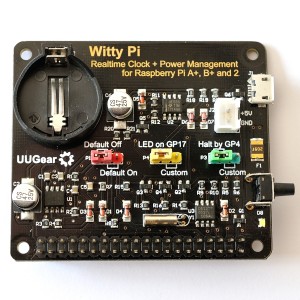
Back in July I did a mailbag video and got you guys to vote on which item I should do a more in-depth review of. WittyPi got about 50% of the vote by the time I had to make the decision. So here is the UUGear WittyPi review.
WittyPi is an A+/B+/Pi2B add-on that gives you a safe on-off switch and enables timed shutdowns and startups of your Raspberry Pi. It has a battery-backed realtime clock (RTC) that controls the startup times and allows your Pi to retain the correct time even if not connected to the internet. (The Pi has no on-board RTC of its own).
Video Review
This is a video review, so have a look at the video to see how it pans out in full.
Installation
I used the most recent Raspbian and followed the installation instructions on page 6 of the WittyPi manual. Installation went perfectly.
Once the software was installed, I shut down the Pi, attached the hardware (I chose to use just two of the four provided spacers) and powered it back up again.
About a minute after powering up, the following message appeared…
Writing system time to RTC...
Done :-)
…showing me that the Pi had checked online to update the time, then passed this information to the WittyPi, which now wrote it to the RTC.
After that I tested all the features of the WittyPi including…
- Safe On/Off switch for the Pi
- Realtime clock setting
- Timed shutdown
- Timed startup
- Multiple scheduled startups/shutdowns using a script
It all worked well. There is a full explanation of the software features/functions and a walkthrough of it in the video.
Bottom Line?
WittyPi is well made, attractive and works well. It’s a very good price at £10.
If you need to be able to auto-start and auto-shutdown your Pi, this is the board for you. You can get one here.

Alex
I had the following problem when using WittyPi , as I did not notice that GPIO-4 was currently in use within my program and this caused problems. So to be on the safe side ensure that GPIO-4 is not called up by any program while WittyPi is connected, otherwise a full lockup will occur during the program run.
Derek
Hi Derek, if GPIO-4 is already in used, you can change the pin used by Witty Pi. Here is a tutorial: http://www.uugear.com/portfolio/change-the-pin-that-used-by-witty-pi/
Great review as always Alex.
Out of interest I don’t suppose you got a chance to measure the idle current when the Pi is off but scheduled to come on did you? I’m guessing/hoping its nothing/extremely low, because if that’s the case it would be great for solar or battery projects where you need to do a short activity but regularly on a schedule without using any power during the downtime.
I haven’t measured it, but in the manual it says power to the Pi is completely cut off. There will be a little power used by the occasional pulsing of the LED and perhaps the chips require a teeny amount, but I would expect it to be really small – micro or milliamps.
Yeah thats what I was hoping.
Hi Daniel, I have ever tested the idle current of Witty Pi, and it is usually a few mAs (4~8mA in my testings).
Excellent, thanks..
Seems interesting, but does it work on the standard model B? The one with two USB ports?
No it won’t even fit because of the 40 pin header on the WittyPi board.
I did say in the review that it’s for A+/B+/Pi2B
what if you used a 40 pin IDE connector?……just a thought…
This can work, and one of our customers already did that and succeeded :-)
You will need to connect the +5V, GND, GP4, GP17, GP2(SDA), GP3(SCL) and GP14(TXD) between Raspberry Pi and Witty Pi.
I’ve had a Witty for a few weeks and I really like it.